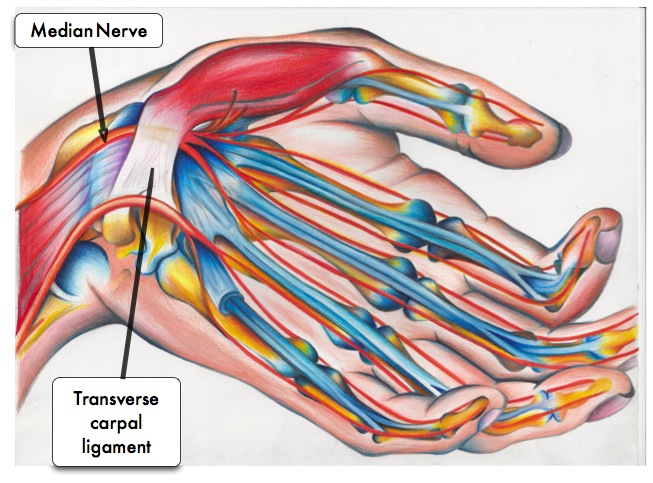Summary
The Basics - CTS in a nutshell
Carpal tunnel syndrome is a characteristic combination of symptoms, with or without examination findings, which result from a problem with one of the major nerves to the hand (the median nerve). This nerve is located in the carpal tunnel (carpal - from the greek word karpos, meaning 'wrist'), which lies at the heel of the hand. The tunnel is the gap between the bones of the wrist and the transverse carpal ligament - a fibrous band which, in part, holds the wrist together.

(Illustration by N Bland after an original by Claudia M Grosz)
It is widely believed that the nerve injury occurs because of raised pressure in the carpal tunnel thus giving rise to the term ‘entrapment’ neuropathy - neuropathy simply being 'medicalese' for any problem with a nerve, but there are dissenting views. The increased pressure in the tunnel may have an obvious cause but in most cases these are not present and such cases are termed ‘idiopathic’ CTS.
The most characteristic symptoms are tingling (paraesthesiae) and numbness in the fingers which tend to wake the sufferer in the middle of the night. Anyone who experiences this regularly should consider the possibility that they may have CTS. The diagnosis is usually easily made from the description of the symptoms but several confirmatory tests are available. In the later stages symptoms become constant rather than intermittent and eventually there is weakness and wasting of the muscles at the base of the thumb...
Some cases present with only minor symptoms and may require no active treatment, simply reassurance as to the nature of the problem. When symptoms are a nuisance most can be successfully treated without surgery but a substantial minority will require an operation. Some operations are unsuccessful, as with any surgical procedure, and this group of patients present special problems which are discussed in a separate page.
For a more detailed description of the disorder START HERE
Revision date 17th October 2020

